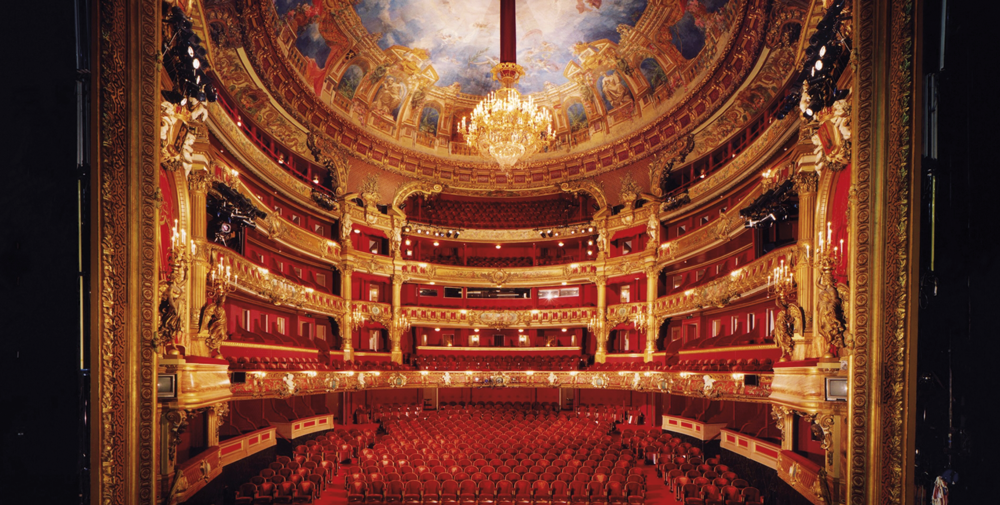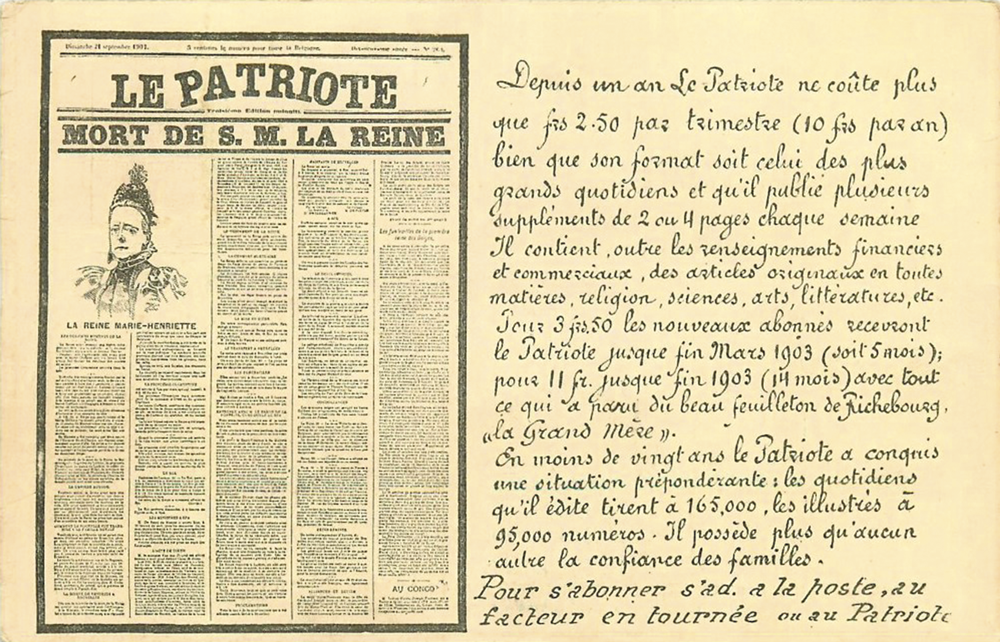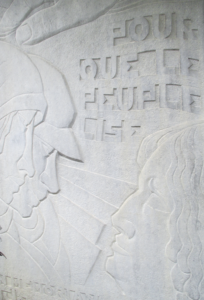The press walk in Brussels
There is a special walk devised for journalists and supported by “La Fonderie” (Rue Ransfort 27, 1080 Molenbeek), which we have followed and want to share with you. It was launched in 2015 on the occasion of “Les Journees du Patrimoine” (Heritage Days).
The tour starts at La Monnaie, the Brussels opera house, which has played an important role in Belgium’s history. It was here that the “Belgian revolution” started on 25 August 1830 after the opera “The dumb girl of Portici” was performed at La Monnaie. The opera written by Daniel Auber with the libretto by Germain Delavigne and Eugene Scribe is based on the story of Masaniello, a man of the people who started a revolution in Naples in 1647 against the ruling Bourbon king. When the character Masaniello launched his battle cry “Aux armes citoyens” from the stage followed by the choir singing “Amour sacré de la patrie” the already excited audience was enflamed and stormed out of the opera house shouting “Aux armes” against the ruling Dutch King William I of Orange. Already upset by the results of the Vienna Congress in 1815 which ended the Napoleonic era, the enraged Belgians decided to attack the newspaper “Le National” favourable to the ruling kings and then sacked and plundered the house (close to the present site of the Musical Instrument Museum) of Count Libry Bagnano, a French bookseller and owner of the newspaper who had made a fortune as a follower of Napoleon Bonaparte but who had fled France after being found guilty of forgery. The curtains of his house were used by the shouting crowds as a flag and the colours happened to be black, yellow and red, the new flag of an independent Belgium!
The newspaper “Le Courrier des Pays Bas” reported the story describing the euphoria of the Belgians. The headquarters of “Le National” was where the former offices of CGER were (rue Fossé-aux-Loups with their distinctive metalwork decoration by Paul Hankar). At that time a newspaper cost as much as a loaf of bread.
Behind the opera house there was a Dominican convent, for a long time abandoned though now a hotel and a cafe. It was near here that the offices of the first catholic newspaper “Le Patriote” were housed. It was followed by a catholic newspaper which is still published today, “La Libre Belgique”, which upheld the cause of schools in Belgium, above all catholic teaching and criticised the colonial attitudes of the country towards the Congo.
But at the time there were neither worker political parties nor catholic ones. They were created only in the 1880s and the newspapers were mainly expressing opinions, seldom facts. However the freedom of expression and association were already in the 19th century important features of Belgium in general and of the Belgian press in particular. And this attracted libertarians from all over Europe. During the 19th century many writers and philosophers from Victor Hugo to Karl Marx sought refuge in Belgium. This freedom of expression is still today a feature of the press in Belgium and in Belgium society where legislation is less restrictive towards those who want to express their opinion.
The newspaper “Le Patriote” became the champion of this freedom in 1849 when the battle for confessional and state schools raged. Several initiatives were launched by humanists and liberals, each one defending their point of view and their freedom to teach according to their own principles. But even after schooling was secularised in 1879, a majority of pupils (66%) preferred catholic schools in spite of the great number of schools created by the liberals. At that time schools for girls were created opposing the idea that women were tied to the house and had no reason to study. Special independent schools for girls were created – especially by Mme Gatti de Gamon – where history and sciences were taught in addition to cooking and sewing. But even for girls with school diplomas the university was not an option.
During the First World War “Le Patriote” continued to appear but it was circulated clandestinely and those who wrote for and printed the newspaper risked their lives and many lost theirs. After the Second World War it was replaced by “La Libre Belgique” on the initiative of the catholic Cardinal Mercier.
Both newspapers were housed in Rue du Persil and Rue du Fossé-aux-Loups. It was important to have newspapers printed centrally to facilitate distribution by using the available means of transport at that time. A distribution company was created expressly for this purpose by Louis Bertrand, the founder of “Le Journal du Peuple” and alderman for finance in the Schaerbeek municipality. He also promoted the creation of bread baking cooperatives (bread and newspapers were always linked in Belgium) and the Messageries de la Presse for printing.
The Messageries was subsequently sold to Havas, a major French group, but to guarantee press independence the “Association Autonome de la Presse Belge” was created, the first Independent Belgian Press Association to defend the rights of journalists and the press in general. In 1921 the news agency Belga was created to provide both reliable information and clearly indicate the sources of the information. In 1887 the daily “Le Soir” was created and for the first time in Belgium a newspaper was financed from advertising revenue.
In Rue du Persil the Union of Newspaper Producers was established in 1847 to decide together with newspaper editors how to distribute newspapers which initially were delivered by rail. In Flanders the debate was more complicated since at that time the Francophone press was much more popular than the one in Flemish. Newsprint for newspapers arrived at the port of Antwerp where the price was lower than in Brussels. This encouraged the creation of the Port of Brussels linked through a canal to the Antwerp harbour whereby Brussels then became a “sea harbour” and thus able to enjoy a lower price for its newsprint and much else besides.
In Rue du Persil there were the headquarters of the Freemasons and the debates between the catholic “Le Patriote” and the Masonic centre were constant.
If you continue along Rue du Marais you arrive at Rue des Sables once upon a time the “Fleet Street” of Brussels. Rue des Sables was a thriving street for printing and the press and where there was a convent of St. Elizabeth a big printing works was created. It lay close to many tram routes and lorries transported the printed newspapers. Besides the bigger newspaper titles already mentioned there were , “Le Laboureur”, le “Petit Journal” and le “Petit Bleu”. There was considerable collaboration among them helped by their proximity. One of the newspapers was “La Reforme” which became a staunch defender of the French artillery officer Alfred Dreyfus, accused of treason. The Jewish journalist and anarchist Bernard Lazare campaigned for his exoneration using the phrase “J’accuse” (later picked up by Emile Zola), in an article in L’Eclair, on 15 September 1896 which was republished in Belgium under the title “The Dreyfus Affair – A Miscarriage of Justice”, in November 1896. The Belgian media was active in the defence of Dreyfus with “Le Soir” publishing articles on the affair calling it “the most extraordinary judicial mistake”. In 1897 it was “La Reforme” who wrote openly about the innocence of Dreyfus and published a letter that had never been taken into consideration during the trial. The newspaper “L’Aurore” became the “voice” of the defenders of Dreyfus and it was on its pages on 13 January 1898 that Emile Zola published his famous article “J’accuse”. After his exoneration Dreyfus attended the ceremony to move Émile Zola’s ashes to the Panthéon in 1908, only for a disgruntled journalist (Louis Gregori) to attempt to assassinate him.
After the Second World War the newspaper “La Cité” was created by the Christian movement. In 1885 “Le Peuple”, a cooperative newspaper was created as the newspaper of the workers party in Belgium. At first “La Reforme” printed “Le Peuple”, then “Le Peuple” created its own premises in Rue du Persil were the cooperative bakery had also been installed. The newspaper fought a long battle to improve the pay of workers and for universal suffrage.
The building is still there, Art Nouveau on the top, Art Deco at the entrance. At its peak the street was full of life, bars and eating -places; not far away were some red light areas. The later building of “Le Peuple” is round the corner, a classic example of Art Deco with the portraits of Louis Bertrand, Joseph Wauters and Cesar de Paepe.






